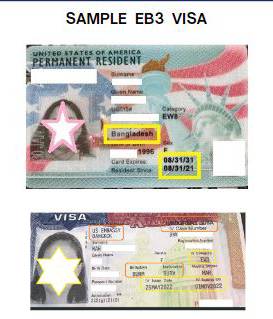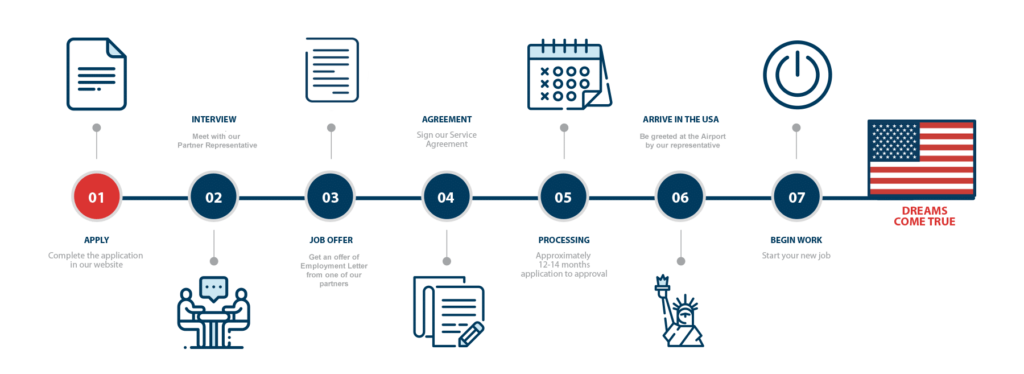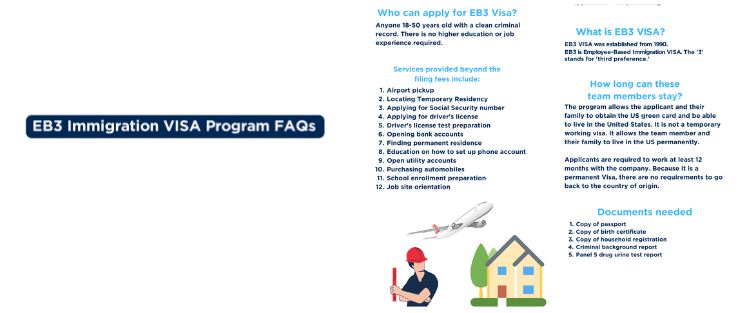The EB3 visa is a powerful option for professionals, skilled workers, and unskilled workers hoping to get permanent residency in the United States. Through the EB3 visa, a U.S. company can sponsor a foreign worker for a green card through a full-time job offer.
To sponsor a foreign worker, the U.S. company must try to first hire a qualified U.S. worker. Only after the U.S. company has attempted and failed to recruit a qualified U.S. worker, can they sponsor a foreign worker. To learn more about the EB3 visa process, you may see our employer sponsored green card post here.
Of the total green cards available for foreign workers, 28.6% are allocated towards the EB3 visa. Therefore, approximately 40,000 EB3 visas are available per year. Additionally, no more than 7% of the total EB3 visas can go to nationals of any one country.
There are 4 main parts to the EB3 visa process:
Step 1: PERM Labor Certification
Step 2: I-140 Petition
Step 3: Wait for Priority Date
Step 4: Consular Processing or Adjustment of Status
I will explain each of these steps and the processing time of each step below. If you have any questions, my team and I would be happy to help you.
Step 1: PERM Labor Certification (About 10 Month Total Processing Time)
The first step in the EB3 visa process is for the U.S. employer to get an approved PERM labor certification. As I mentioned above, before a U.S. employer may sponsor a foreign worker, they must attempt to hire a qualified U.S. worker. It is only after they try and fail to hire a U.S. worker, that the U.S. employer can sponsor a foreign worker for a green card. Once the U.S. employer successfully goes through the PERM process, they receive a labor certification from the U.S. Department of Labor. Getting an approved labor certification is required for the employer to sponsor a foreign worker under the EB3 visa. This process usually takes about 10 months.
Step 2: Form I-140 Immigrant Petition (6 to 9 Month Standard Processing Time, 15 Day Premium Processing Available)
Once the PERM labor certification is approved by the Department of Labor, the next step is for the employer to submit a Form I-140 to USCIS. The Form I-140 is the immigrant petition and it is filed by the U.S. employer on behalf of the foreign worker. Once the form I-140 is filed, it usually takes 6-69 months to get a response from USCIS. The US employer can also elect to pay an additional $1,440 for premium processing, to receive a response in 15 days. If USCIS has any concerns about the petition, they may render a Request for Evidence (RFE). This can also slow down the processing time.
Step 3: Wait for Your Priority Date to Become Current (0 to 10+ Years)
When you submit your Form I-140 immigrant petition you will also receive a priority date. Your priority date will tell you when you can schedule your immigrant visa interview or apply for adjustment of status (next step). For some countries, there is no wait time and you can schedule a visa interview immediately.
Step 4: Consular Processing or Adjustment of Status (About 9 Months)
Once the Form I-140 is approved and your priority date is current, the next step is to apply for the foreign worker to apply for an immigrant visa or apply for an adjustment of status.


If you are outside of the United States, you will likely apply for an immigrant visa. This is done by filing a Form DS-260. Several months after filing the DS-260 you will be required to attend a visa interview at the consulate or embassy of your home country. Following successful completion of the interview, you should receive your immigrant visa stamped into your passport. This whole process takes about 9 months.
If you are lawfully present in the United States in a valid non-immigrant status, you may be eligible to do apply for an adjustment of status. An adjustment of status is the process of going from a non-immigrant status to permanent resident status while in the United States. To apply for an adjustment of status the EB3 visa beneficiary (the foreign worker) must file a Form I-485 with USCIS. The adjustment of status process takes about 9 months to complete. One benefit of the adjustment of status is that the work authorization (EAD) and advance parole (travel permission) usually arrive within 6 months.
One of the benefits of an adjustment of status is that, if your priority date is current, you can concurrently file your form I-485 (adjustment of status) along with your Form I-140 (immigrant petition). Doing this can save you time on the overall EB3 processing time. If you’d like to know whether you’re eligible to do this, please email me directly at info@globalvisais.com.
PERM labor certification: approximately 10 months (without audits)
• Form I-140 Petition: approximately 6-9 months (or 15 days with premium processing)
• Priority Date wait approximately 0 to 10+ years
• Adjustment of Status or Visa Processing: about 9 months
Therefore, the EB3 processing time should take between 1 and 3 years for most EB3 visa applications to be processed. Yet, it can be longer for people of some countries. If you have any questions about the EB3 processing time or about the EB3 visa in general, my team and I would be happy to help.

Form I-140 (“Immigrant Petition for Alien Worker”):
Filing Fee: $715 Premium Processing $2805
Immigrant Fee: $235
Form I-485 (Adjustment of Status Application):
Filing Fee: $1,440
Biometrics Fee: $85 (required for applicants aged 14 to 79)
Form I-140 (“Immigrant Petition for Alien Worker”):
Filing Fee: $715 (paid by the employer sponsoring you)
Form DS-260 (Green Card Application):
Filing Fee: $345
Form I-864 (“Affidavit of Support”):
Filing Fee: $120
Biometrics Fee:
Fee: $85 (required for applicants aged 14 to 79)
EB3 Application procedures from foreign worker File Form DS-261, Choice of Address and Agent
This is an online form which the foreign worker must fill in each section and submit it. The form serves as a visa application for the foreign worker to the US Embassy in their country of residence. When you as the foreign worker submit this form, you will get a confirmation page which you will send to the NVC with your supporting documents.
Complete medical examination and vaccination
To move to the US permanently, you must meet the health requirements too. This means that you will have to go through the NVC package and visit a licensed doctor to complete the necessary documents and checkups. If you do not have all the vaccines, then you will also need to take them.
Compile the EB3 visa supporting documents file
After the NVC approves your Form DS-261, you must send the supporting documents for your case.
The documents required for an EB3 visa application are the following:
Your passport which must be valid for more than 6 months after your intended departure to the US
Your employment offers from the US employer
The approved labor certification
The approved petition
Your DS-261 confirmation page
Your signed medical and vaccine documents
Two photographs meeting the US Visa Photo Requirements
Academic achievements (diplomas and certificates)
Your CV or resume
Court and criminal records
Depending on the case, the NVC might require other supporting documents, so you must follow their instructions carefully.
EB3 visa is a great option for professionals, skilled workers, and unskilled workers hoping to get permanent residency in the United States. There are several steps in receiving an EB3 visa application.
